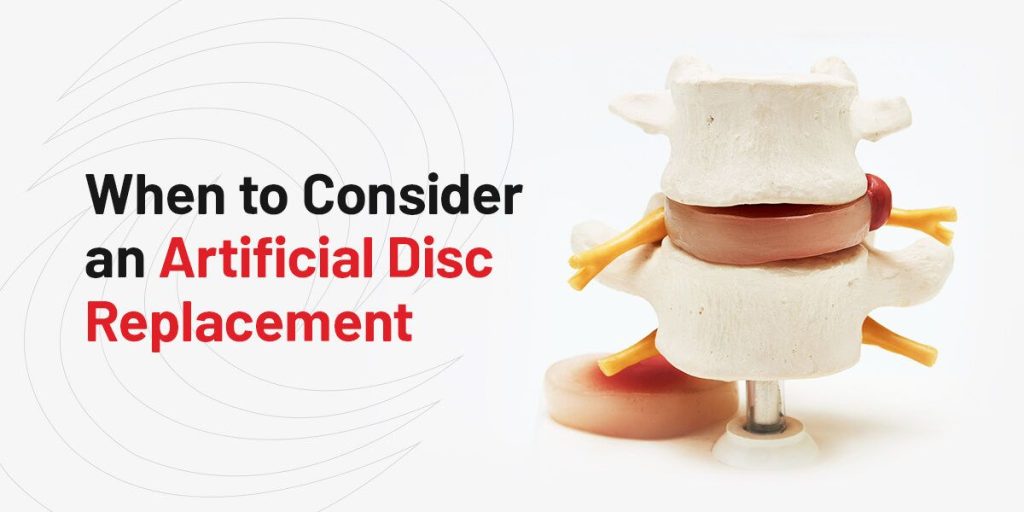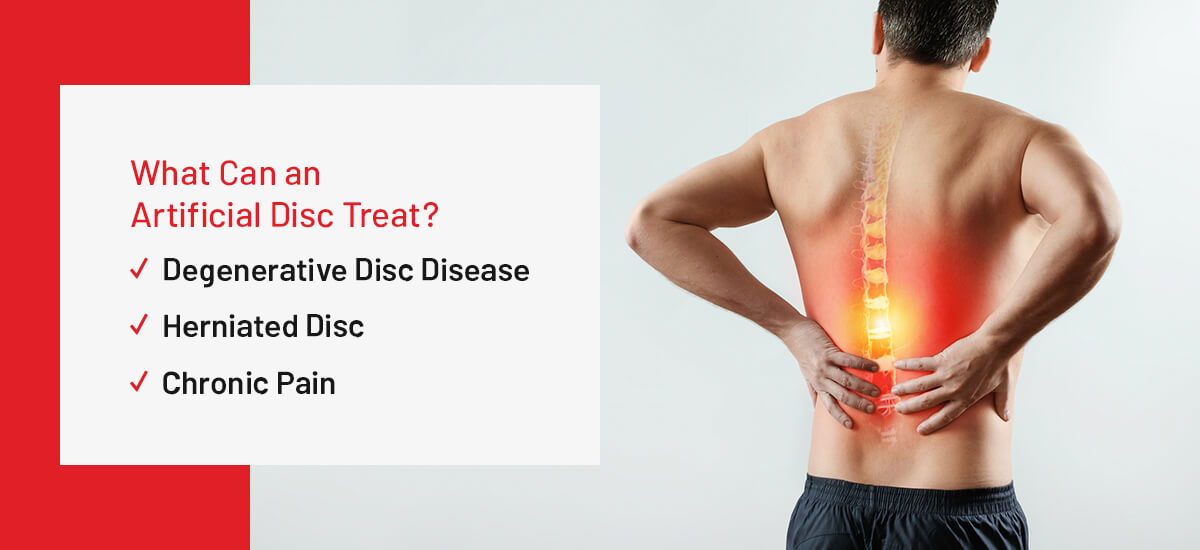
Chronic back or neck pain can develop due to numerous conditions. In many cases, unhealthy or damaged intervertebral discs cause chronic back pain. These spinal discs provide a layer of cushion between the vertebrae and help absorb pressure and stress placed on the spine.
When these spinal discs experience damage during an accident or become unhealthy with age, the vertebrae may come into direct contact, causing discomfort. Fortunately, innovative treatments and artificial disc replacement surgery are available to improve these unpleasant symptoms.
Visit Here to Schedule an Appointment
Artificial disc replacement, also commonly referred to as cervical ADR, is a back disc replacement surgery that swaps damaged or diseased intervertebral discs with an artificial joint. In performing disc replacement surgery, a physician puts a metal and plastic mechanical device between the vertebrae in place of the problematic or unhealthy disc.
The primary goal of total disc replacement is to treat chronic pain or uncomfortable symptoms related to an unhealthy spinal disc. Artificial disc replacement surgery is an effective alternative to spinal fusion surgery for patients looking for relief from chronic back pain. The artificial cervical disc allows the spine more range of motion and mobility.
Artificial spinal disc surgery alleviates pain by removing a damaged or unhealthy spinal disc and putting in a replacement. This spinal segment can retain its mobility due to the prosthetic implant. Spinal disc replacement is similar to a knee or hip replacement, as its goal is to remove a damaged portion of the body and introduce a prosthesis to improve painful symptoms.
There are numerous ways to perform artificial disc replacement, depending on your symptoms’ severity and unique needs. In some cases, spinal surgeons can perform artificial disc replacement in a minimally invasive procedure. On the other hand, some artificial disc surgeries may require a more traditional approach with an incision along the back or neck to access damaged discs.
Artificial disc replacement is an innovative procedure to improve various conditions resulting in chronic pain. Approximately 16 million adults experience persistent or chronic back pain. While chronic back pain has many causes, an unhealthy, damaged or decaying spinal disc often plays a role in the uncomfortable symptoms patients may experience.

Some of the most prevalent back conditions an artificial disc can treat include degenerative disc disease, a herniated disc or chronic pain that has not responded to other treatments.
Degenerative disc disease refers to back or neck pain caused by the degradation of the spinal discs. While pain is one of the most common symptoms of degenerative disc disease, some patients may also experience numbness, weakness, or shooting pains in the arms and legs. In most cases, degenerative disc disease often causes low-level chronic pain with episodes of more severe pain possible.
Research has found 40% of people 40 years or older have this condition, with 80% of adults over 80 developing it. Degenerative disc disease’s prevalence increases with age. As our bodies experience more wear and tear, the spinal discs can deteriorate. An artificial disc can replace these damaged discs to restore mobility and improve chronic pain.
A herniated disc is when the spinal disc’s soft center protrudes through a crack or rupture in the exterior casing. While some herniated discs may not cause noticeable symptoms, others can irritate the nearby spinal nerves and result in chronic pain, weakness or numbness. People living with this condition may experience improvement through physical therapy or medication. Those with more severe herniated discs may need artificial disc replacement.
Research has shown that herniated discs typically occur in a person’s 30s to 50s, with a 2-to-1 male-to-female ratio. Herniated disc symptoms vary depending on their location and severity. In most cases, herniated discs develop in the lower back and can affect the middle and upper back, including the neck.
Artificial disc replacement surgery may also be an effective treatment for chronic back pain that has not responded to other treatments. Low back pain is one of the leading causes of activity limitation and causes worldwide work absences. Persistent back and neck pain is uncomfortable and can make daily activities challenging. When chronic pain stems from a damaged or unhealthy spinal disc, total disc replacement may be an effective treatment.
Another spinal surgery that has successfully treated damaged discs is cervical fusion. In performing this procedure, a spine surgeon permanently fuses two or more vertebrae to reduce the range of motion. During spinal fusion surgery, a doctor places bone grafting material between two or more vertebrae. Screws, rods, and metal plates hold the vertebrae together so they can heal into a solid unit as you recover.
In most cases, doctors recommend artificial disc replacement for damaged or unhealthy intervertebral discs. The recovery period for artificial disc replacement is often shorter than spinal fusion surgery. Total disc replacement can also be more effective at relieving chronic back and neck pain. While specialists generally recommend artificial disc replacement, spinal fusion may be necessary in some cases, especially if there is a significant disease in the facet joints.
Artificial disc replacement surgery is an effective treatment method that can improve spinal discomfort and chronic pain. You may be a candidate for artificial disc replacement if you are living with a damaged or unhealthy disc resulting in pain or other uncomfortable side effects. A spinal specialist can help determine if you are a proper candidate for artificial joint replacement. Ideal back disc replacement candidates typically have these characteristics:
Learn More About Artificial Disc Replacement Surgery
The Desert Institute for Spine Care is a leading provider of artificial disc replacement surgery, innovative spinal treatments, and endoscopic spine surgery. Our goal is to quickly and effectively diagnose various spinal conditions so patients can receive prompt treatment to restore mobility and improve their overall quality of life. Our team of expert spinal surgeons and specialists is proud to use their collective 50 years of patient care experience to offer advanced, innovative treatment options.
Schedule an appointment by contacting us online today to learn more about our spinal services.